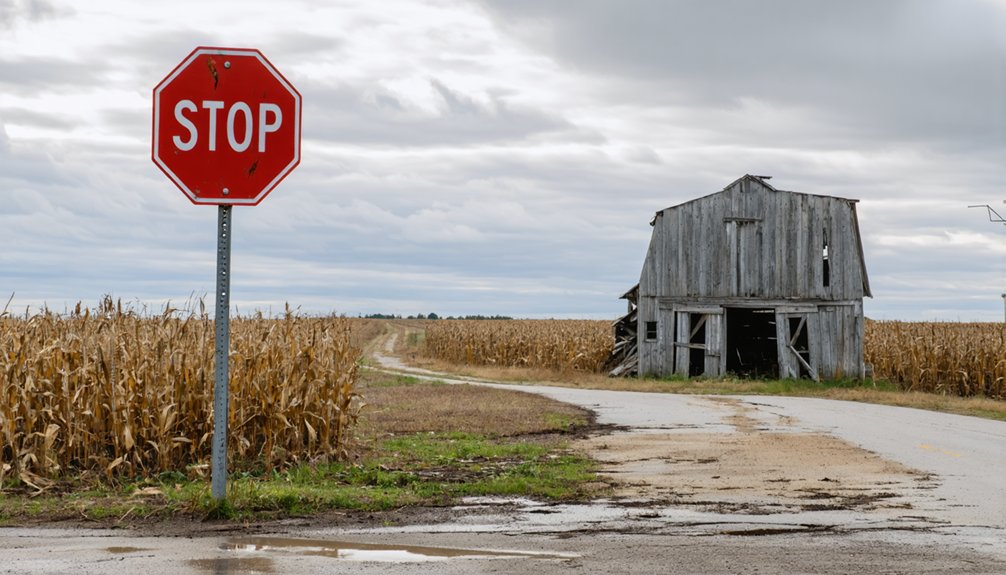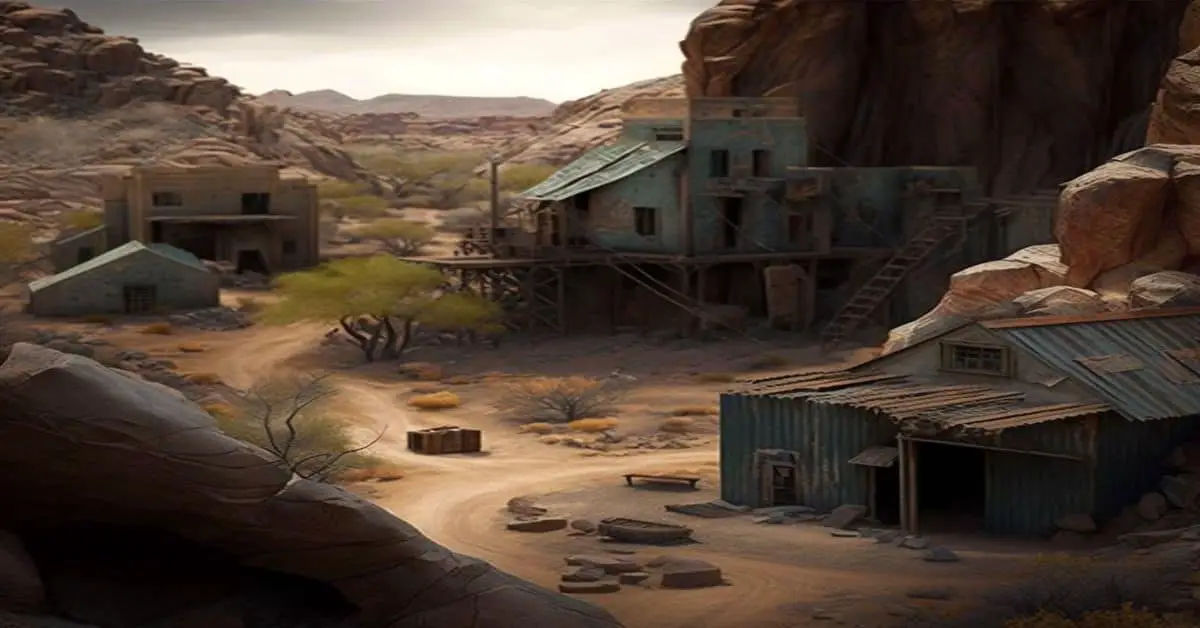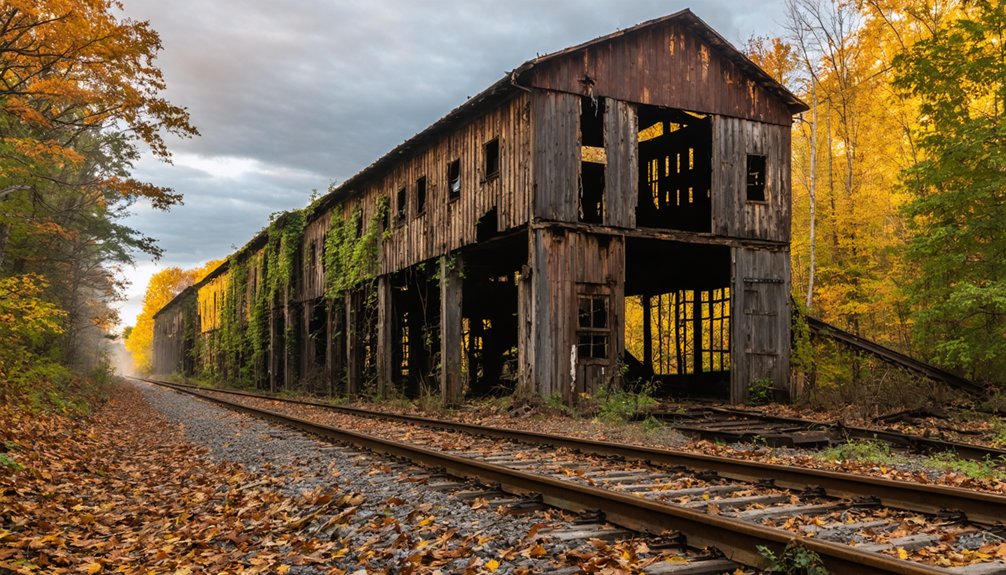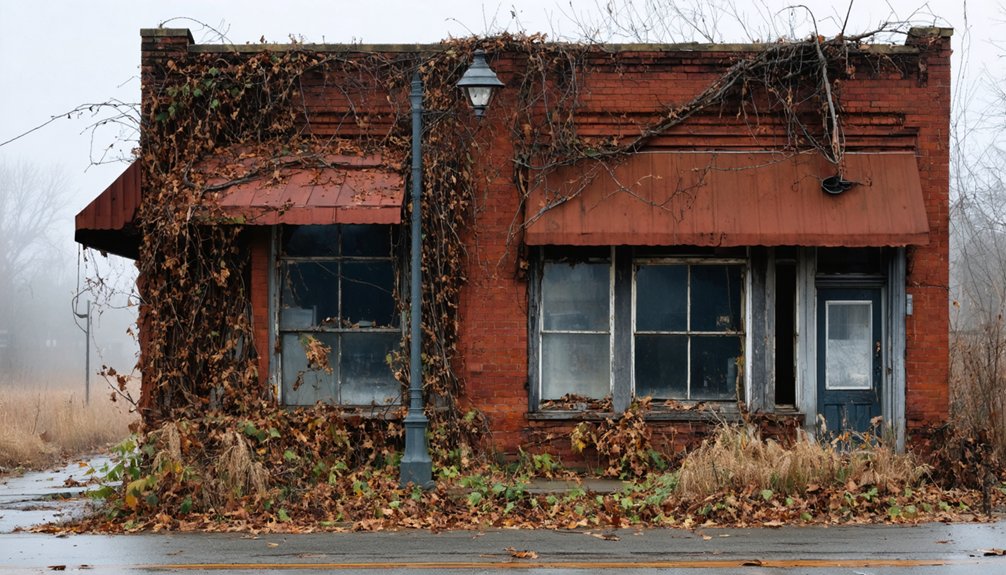You’ll find Corwin’s ghost town remains in Henry County, Indiana, where it flourished as a railroad town in the 1850s. Originally platted with seven lots near the Monon Railroad, the settlement grew from farming roots into a bustling center of commerce. When railroad service ended, the town’s economy collapsed, forcing residents to seek opportunities elsewhere. Today, scattered foundations, the Kermit Naylor house, and artifacts beneath the soil reveal Corwin’s forgotten story.
Key Takeaways
- Corwin was established in Henry County during the 1850s-1860s as a small railroad town with seven lots along the Monon Railroad.
- The town’s economy initially thrived through agriculture and railroad commerce but declined when railroad service ended.
- Limited transportation options and dependence on a single industry led to population decline as residents moved to nearby towns.
- The Kermit Naylor house remains one of the few surviving original structures from Corwin’s inhabited period.
- Archaeological evidence, including ceramics, glass, and rusted tools, provides insights into 19th-century life in this abandoned settlement.
Origins and Settlement of Corwin
While many Indiana settlements flourished during the mid-19th century, Corwin emerged as a modest rural community in Henry County during the 1850s-1860s. Named after a local Corwin family, the town followed typical settlement patterns of the era, as pioneers sought agricultural opportunities in the region. Like most early settlements, the town was established near clean drinking water to sustain the population.
You’ll find that Corwin’s early cultural influences mirrored those of other Indiana pioneer communities, with settlers primarily arriving from Eastern and Midwestern states. The town’s location near transportation routes initially seemed promising, but larger neighboring communities ultimately overshadowed its development. Similar to the town of Granville, Corwin was platted with seven lots near the Monon Railroad.
The settlement attracted farming families and laborers, yet struggled to establish the robust infrastructure needed for growth. Without significant commercial establishments or religious institutions of its own, Corwin remained dependent on nearby towns for essential services.
Life in Early Corwin
How did early settlers manage daily life in Corwin during its formative years? They built a resilient community focused on self-sufficiency and mutual support. Daily life centered around farming, with families working together to clear land and establish homesteads using local materials like wood and clay. Like many Indiana settlers, residents relied on flatboats for transport of their agricultural goods to market. Like many communities of the era, farm laborers made up the majority of the working population.
The community’s liveliness emerged through:
A vibrant spirit defined early settlements, where community bonds flourished through shared experiences and collective gatherings.
- Regular community events, including harvest festivals and church gatherings that strengthened social bonds
- Educational practices that prioritized literacy, despite limited resources
- Shared labor systems where neighbors helped each other with challenging tasks like barn-raising
- Local trade networks that facilitated the exchange of goods and services
Families preserved food for winter, made their own clothing, and relied on folk remedies for medical care.
While life wasn’t easy, the spirit of cooperation and resourcefulness defined Corwin’s early character.
Economic Rise and Development
The economic transformation of Corwin emerged from its humble farming roots into a bustling center of commerce during the late 1800s.
Similar to early mining communities like Wehrum and Bracken, Corwin experienced significant population growth as new industries took hold.
You’d have seen the town’s economic sustainability grow through strategic investments in local industries and infrastructure development. The establishment of new roads connected Corwin to neighboring markets, while government initiatives supported agricultural expansion and manufacturing ventures.
Local craftsmen and skilled traders contributed considerably to the community’s growth, establishing workshops and small factories that drew workers from surrounding areas. Similar to City West’s sawmill, Corwin operated several industrial facilities that employed local residents.
The town’s proximity to essential trade routes and natural resources sparked further development, with banking services and merchant shops opening to serve the growing population.
Community initiatives focused on balancing industrial growth with agricultural traditions, creating a diverse economic base that would sustain Corwin through the changing times.
Factors Leading to Decline
Corwin’s decline began when agricultural markets shifted away from local distribution networks, weakening the town’s farming economy.
You’ll find that the cessation of railroad service dealt a severe blow to the community, cutting off essential transportation links that had sustained commerce and connectivity.
The town’s reliance on a single-industry economy left it particularly vulnerable when that economic base collapsed, triggering a chain reaction of business closures and population loss. Like many abandoned villages across America, Corwin became a victim of changing economic circumstances and industrial shifts. The presence of a larger nearby town accelerated Corwin’s depopulation as residents sought better opportunities elsewhere.
Agricultural Markets Shifted Away
While agricultural prosperity once fueled Corwin’s economic importance, dramatic shifts in commodity markets and farm structures during the early 21st century accelerated the town’s decline.
Agricultural consolidation transformed the local farming landscape, as smaller family operations gave way to large commercial enterprises that bypassed traditional local markets. The trend was evident in 2023 as farmers experienced weak corn basis throughout the marketing year. The shift mirrored broader state patterns where family-operated farms still comprised 87% of operations but required significantly more capital.
You’ll find these market shifts reflected in four key changes:
- Farm numbers dropped 70% while land stayed concentrated in fewer hands
- Local grain markets lost liquidity as farmers stored crops longer during price downturns
- Farmland became more of an investment asset than a productive resource
- Plummeting farm incomes in 2024 reduced spending in small agricultural communities
The disappearance of vibrant local markets ultimately left Corwin without its economic foundation, as larger operations began dealing directly with distant buyers.
Railroad Service Ceased Operations
Following years of declining freight volumes and passenger numbers, railroad operations through Corwin reached their terminal point in the 1990s when crews dismantled the tracks that had once served as the town’s economic lifeline.
This pivotal moment in Corwin’s railroad history marked the end of an era, as the removal of rail infrastructure permanently severed the town’s connection to regional markets.
You’ll find this was a common fate for small Indiana towns during the late 20th century, when major rail companies consolidated operations and abandoned less profitable branch lines.
The service impact rippled through the community – businesses lost crucial supply chains, farmers couldn’t efficiently transport crops, and residents faced limited mobility options.
Without rail connectivity, Corwin couldn’t compete with neighboring towns that maintained better transportation links, leading to its eventual abandonment.
Single-Industry Economy Collapsed
As dependence on railroad operations proved catastrophic for the town’s survival, you’ll find that Corwin exemplified the risks of a single-industry economy in early 20th century Indiana.
The town’s economic vulnerability became apparent as regional market demands shifted away from rail transportation.
The community’s industry reliance led to these devastating consequences:
- Local businesses couldn’t sustain operations once railroad activity declined, forcing closures and relocations.
- Young workers and families migrated to nearby towns like Romney that offered diverse employment options.
- Essential services became unsustainable as the population dwindled and local commerce disappeared.
- Without investment in alternative industries or infrastructure, Corwin couldn’t adapt to changing transportation needs, particularly as automobiles gained popularity.
The lack of economic diversification ultimately sealed the town’s fate, making its decline inevitable once railroad operations ceased.
Historical Significance and Legacy
Despite its eventual abandonment, Corwin left an indelible mark on Indiana’s historical landscape as a proof of 19th-century pioneer settlement and rural development.
You’ll find the town’s cultural heritage preserved in historical records, maps, and local archives that document the determination of early settlers who established this transportation hub. The community’s resilience through its agricultural and railroad-focused economy represents a common story shared by many small Indiana towns of that era.
Today, Corwin’s legacy lives on through preserved photographs, written accounts, and oral histories housed in regional libraries and historical societies.
These records provide valuable insights into pioneer lifestyles, migration patterns, and the social fabric that shaped Indiana’s rural communities during the state’s formative years.
Architectural Remains and Landmarks
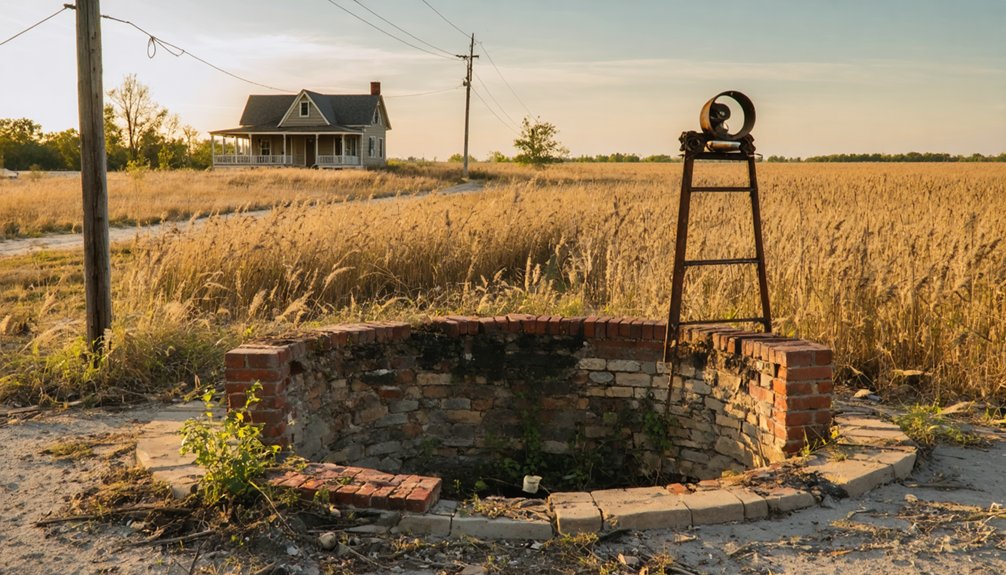
The architectural footprint of Corwin centers on a carefully planned layout of seven lots divided by an alley, typical of small railroad towns along the Monon line.
While most original structures haven’t survived, you’ll find architectural styles reflecting the town’s railroad heritage and Quaker influences. The Kermit Naylor house stands as one of the few remaining historical buildings, though preservation efforts have been limited.
Near Corwin, you’ll discover these significant landmarks:
- The Farmer’s Institute (1851), showcasing Quaker architectural simplicity
- Original railroad track remnants marking the town’s transportation corridor
- Scattered residential foundations revealing early settlement patterns
- Rural wooden structures displaying period construction techniques
Today’s remaining features tell the story of a practical, hardworking community shaped by both railroad commerce and Quaker values.
Present-Day Traces and Discoveries
Modern-day explorers of Corwin’s remnants will find a landscape where nature has steadily reclaimed the once-bustling railroad town.
You’ll notice cleared patches amid the surrounding forest, with overgrown roads and pathways visible through aerial views. Urban exploration reveals scattered artifacts of 19th-century life – ceramics, glass, and metal objects that hint at the town’s past.
Aerial photographs expose ghostly outlines of Corwin’s streets, while fragments of pottery and metal tell stories of its vanished inhabitants.
The site’s archaeological significance continues to grow as ground-penetrating radar and small-scale digs uncover buried foundations and household items.
You’ll discover evidence of daily life in rusted tools, coal stoves, and old bottles that surface after heavy rains. Local historians and community searches have mapped brick clusters and wall remnants, while drone footage helps identify hidden traces in wooded areas.
Frequently Asked Questions
Were Any Notable Crimes or Mysterious Events Reported in Corwin’s History?
Want to know what dark secrets lurk in Corwin’s past? You’ll find one main unsolved mystery – the 1908 tunnel murder of Henry Dixon – but little documented criminal activity beyond that haunting case.
What Native American Tribes Originally Inhabited the Area Before Corwin’s Establishment?
You’ll find that the Miami Tribe dominated the region as the largest group, while the Potawatomi Tribe lived north of the Wabash River and moved seasonally through the area’s hunting grounds.
Did Any Famous People Ever Visit or Stay in Corwin?
Like footprints in shifting sand, historical records haven’t preserved any evidence of famous visitors or historical figures spending time in your town’s brief existence during its railroad days.
Were There Any Documented Epidemics or Health Crises in Corwin?
While there aren’t any specific epidemic outbreaks recorded for Corwin, you’ll find it was likely impacted by Indiana’s 1849 cholera crisis and 1918 flu pandemic, though local health statistics weren’t documented.
What Natural Resources or Minerals Were Found in the Corwin Area?
You’d find vast deposits of limestone dominating the area’s resources, with active quarrying operations extracting construction materials. Calcite, dolomite, quartz, and fluorite crystals were also abundant in local formations.
References
- http://ingenweb.org/intippecanoe/ghosttowns.htm
- https://www.geotab.com/ghost-towns/
- https://kids.kiddle.co/Corwin
- https://en.wikipedia.org/wiki/List_of_ghost_towns_in_Indiana
- https://www.onlyinyourstate.com/experiences/indiana/ghost-towns-in
- https://commons.wikimedia.org/wiki/File:Corwin
- https://kids.kiddle.co/List_of_ghost_towns_in_Indiana
- https://www.youtube.com/watch?v=45D4dbASJyE
- http://ingenweb.org/inlawrence/abandoned.htm
- https://www.aol.com/articles/abandoned-gold-mining-town-one-112745636.html
